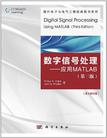数字信号处理
出版时间:2012-1 出版社:科学出版社 作者:(美)英格尔 等著 页数:595
Tag标签:无
内容概要
本书介绍了MATLAB在数字信号处理中的应用,包括时分信号与系统、时分傅里叶变换、z变换、离散傅里叶变换、离散时间滤波器实现、FIR滤波器设计、IIR滤波器设计以及采样率转换等内容。本书通过使用MATLAB这一“动态实验室”
帮助读者提高解决问题的能力和严谨思维的能力。
《数字信号处理--应用MATLAB(第3版英文影印版)》可作为电子工程、通信专业的双语教材或教学参考书,也可供工程技术人员参考。
作者简介
作者:(美)Vinay K. Ingle,(美)John G. Proakis
书籍目录
PREFACE
1 INTRODUCTION
1.1 Overview of Digital Signal Processing
1.2 A Brief Introduction to MATLAB
1.3 Applications of Digital Signal Processing
1.4 Brief Overview of the Book
2 DISCRETE-TIME SIGNALS AND SYSTEMS
2.1 Discrete-time Signals
2.2 Discrete Systems
2.3 Convolution
2.4 Difference Equations
2.5 Problems
3 THE DISCRETE-TIME FOURIER ANALYSIS
3.1 The Discrete-time Fourier Transform (DTFT)
3.2 The Properties of the DTFT
3.3 The Frequency Domain Representation of LTISystems
3.4 Sampling and Reconstruction of Analog Signals
3.5 Problems
4 THE z-TRANSFORM
4.1 The Bilateral z-Transform
4.2 Important Properties of the z-Transform
4.3 Inversion of the z-Transform
4.4 System Representation in the z-Domain
4.5 Solutions of the Difference Equations
4.6 Problems
5 THE DISCRETE FOURIER TRANSFORM
5.1 The Discrete Fourier Series
5.2 Sampling and Reconstruction in the z-Domain
5.3 The Discrete Fourier Transform
5.4 Properties of the Discrete Fourier Transform
5.5 Linear Convolution Using the DFT
5.6 The Fast Fourier Transform
5.7 Problems
6 IMPLEMENTATION OF DISCRETE-TIME FILTERS
6.1 Basic Elements
6.2 IIR Filter Structures
6.3 FIR Filter Structures
6.4 Lattice Filter Structures
6.5 Overview of Finite-Precision Numerical Effects
6.6 Representation of Numbers
6.7 The Process of Quantization and Error Characterizations
6.8 Quantization of Filter Coefficients
6.9 Problems
7 FIR FILTER DESIGN
7.1 Preliminaries 304
7.2 Properties of Linear-phase FIR Filters
7.3 Window Design Techniques
7.4 Frequency Sampling Design Techniques
7.5 Optimal Equiripple Design Technique
7.6 Problems
8 IIR FILTER DESIGN
8.1 Some Preliminaries
8.2 Some Special Filter Types
8.3 Characteristics of Prototype Analog Filters
8.4 Analog-to-Digital Filter Transformations
8.5 Lowpass Filter Design Using MATLAB
8.6 Frequency-band Transformations
8.7 Problems
9 SAMPLING RATE CONVERSION
9.1 Introduction
9.2 Decimation by a Factor D
9.3 Interpolation by a Factor I
9.4 Sampling Rate Conversion by a Rational Factor I/D
9.5 FIR Filter Designs for Sampling Rate Conversion
9.6 FIR Filter Structures for Sampling Rate Conversion
9.7 Problems
10 ROUND-OFF EFFECTS IN DIGITAL FILTERS
10.1 Analysis of A/D Quantization Noise
10.2 Round-off Effects in IIR Digital Filters
10.3 Round-off Effects in FIR Digital Filters
10.4 Problems
BIBLIOGRAPHY
章节摘录
版权页: 插图: These applications and products require many interconnected complex steps, such as collection, processing, transmission, analysis, audio/display of real-world information in near real time.DSP technology has made it possible to incorporate these steps into devices that are inno vative, affordable, and of high quality (for example, iPhone from Apple,Inc.).A typical application to music is now considered as a motivation for the study of DSP. Musical sound processin,g In the music industry, almost all musical products (songs, albums, etc.) are produced in basically two stages.First, the sound from an individual instrument or performer is recorded in an acoustically inert studio on a single track of a multitrack recording device.Then, stored signals from each track are digitally processed by the sound engineer by adding special effects and combined into a stereo recording,which is then made available either on a CD or as an audio file. The audio effects are artificially generated using various signalprocessing techniques.These effects include echo generation, reverberation (concert hall effect), flanging (in which audio playback is slowed down by placing DJ's thumb on the flange of the feed reel), chorus effect(when several musicians play the same instrument with small changes in amplitudes and delays), and phasing (aka phase shifting, in which an audio effect takes advantage of how sound waves interact with each other when they are out of phase).These effects are now generated using digital-signal-processing techniques.We now discuss a few of these sound effects in some detail. Echo Generation The most basic of all audio effects is that of time detay, or echoes.It is used as the building block of more complicated effects such as reverb or flanging.In a listening space such as a room, sound waves arriving at our ears consist of direct sound from the source as well as reflected off the walls, arriving with different amounts of attenuation and delays. Echoes are delayed signals, and as such are generated using delay units.For example, the combination of the direct sound represented by discrete signal y(n) and a single echo appearing D samples later (which is related to delay in seconds) can be generated by the equation of the form(called a difference equation)
编辑推荐
《数字信号处理:应用MATLAB(第3版)(英文影印版)》是“国外电子与电气工程经典图书系列”之一,可作为电子工程、通信专业的双语教材或教学参考书,也可供工程技术人员参考,书中介绍了MATLAB在数字信号处理中的应用,包括时分信号与系统、时分傅里叶变换、z变换、离散傅里叶变换、离散时间滤波器实现等。
图书封面
图书标签Tags
无
评论、评分、阅读与下载
用户评论 (总计11条)
- 非常经典的一本书,对于学习数字信号处理很有帮助
- 学习matlab的好教材,可以提高英语水平
- 这本书还是挺好的,讲的比较细致。
- 英文版在国内买太实惠了,很有性价比
- matlab好教材,可以提高英语水平
- 灰常灰常不错的书哦
- 书挺好的。印刷也好
- 一开始买这书挺激动的,后来发现图书馆有。当然还是有一本好,能很随意的做记号,对学习很有用。
- 收到书后有点小失望,本书有如下缺点:1.纸很薄;2.删掉了原版中的第11章、第12章和Index部分;一看就知道是为了节约成本,但是书的卖的一点都不便宜,不建议大家买。
- 我手里有这书的电子版,电子版672页,怎么这里的只有500多页,难道少了几章?本想收藏一本的,看来不敢下手了。
- 很不错的书,讲述的很详细。可惜没有答案~~
